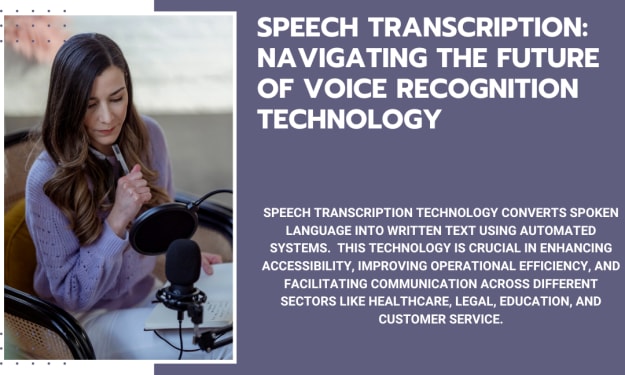Audio Transcription in AI and ML
The Importance of Audio Transcription in AI and ML

Audio transcription in AI and ML converts spoken language into text, providing crucial data for training and refining models. This enhances speech recognition and natural language processing accuracy. By improving accessibility and making audio content searchable, transcriptions drive advancements in AI and ML, supporting applications across various industries.
1. Improved Data Quality: Transcription provides high-quality, structured data essential for AI training.
2. Enhanced Speech Recognition: Accurate transcriptions enhance speech recognition systems.
3. Better NLP Performance: Provides context-rich data for natural language processing.
4. Real-Time Applications: Enables live transcriptions for instant use cases like live captioning.
5. Accessibility: Makes audio content accessible to those with hearing impairments.
6. Searchability: Converts audio into searchable text, facilitating easier data retrieval.
7. Compliance: Helps meet regulatory requirements in sectors like healthcare and legal.
8. Documentation: Ensures accurate documentation for various professional fields.
9. Content Creation: Assists media and educational content creation.
10. Operational Efficiency: Streamlines business operations through outsourcing transcription tasks.
11. Global Reach: Supports translation and localization for a broader audience.
12. Error Reduction: Reduces errors in AI applications through precise data.
13. Data Analysis: Facilitates deeper data analysis and insights.
14. Innovation and Growth: Drives innovation by providing critical data for new AI developments.
15. Knowledge Sharing: Aids in academic and research documentation and dissemination.
16. Resource Optimization: Optimizes resource allocation in businesses.
17. Customer Insights: Enhances customer interaction analysis in market research.
In-Depth Analysis
Improved Data Quality
Audio transcription transforms unstructured audio data into structured text, making it easier to analyze and use in AI training. High-quality data is crucial for developing accurate and reliable AI models.
Enhanced Speech Recognition
Transcriptions provide the foundation for training speech recognition systems. By offering diverse examples of speech, including various accents and dialects, transcriptions help these systems learn to recognize and interpret spoken language more accurately.
Better NLP Performance
Natural Language Processing (NLP) models benefit significantly from transcriptions. The text provides context and nuance that help these models understand language intricacies, improving tasks like sentiment analysis, machine translation, and text summarization.
Real-Time Applications
Live transcription services convert spoken language into text in real-time. This is particularly useful for applications such as live captioning during events, instant translations, and interactive voice response systems, enhancing user experience and engagement.
Accessibility
Transcriptions make audio content accessible to individuals with hearing impairments. By converting speech into text, transcriptions ensure that everyone can access and understand the content, promoting inclusivity and compliance with accessibility regulations.
Searchability
Textual data derived from audio is easily searchable. This feature is invaluable in fields like media, education, and legal, where quick access to specific information is often needed. Transcriptions enable efficient data retrieval, saving time and effort.
Compliance
In regulated industries such as healthcare and legal, maintaining accurate records is essential for compliance. Transcriptions document patient interactions, treatment protocols, court proceedings, and client interviews, ensuring that all critical information is recorded clearly and systematically.
Documentation
Accurate documentation is vital in many professional fields. Transcriptions provide a reliable way to document important conversations, meetings, and interviews, preserving information for future reference and use.
Content Creation
In the media and educational sectors, transcriptions support content creation by providing a written record of interviews, lectures, and seminars. This text can be used to create articles, scripts, and educational materials, expanding the reach and impact of the original content.
Operational Efficiency
By outsourcing transcription tasks, businesses can streamline their operations. This allows them to focus on core activities, improving overall productivity and resource management.
Global Reach
Transcriptions enable accurate translation and localization of audiovisual content. This expands the market reach for media productions and other content, catering to global audiences.
Error Reduction
High-quality transcriptions reduce errors in AI applications. Precise data helps AI models learn more effectively, resulting in fewer mistakes and improved performance.
Data Analysis
Transcriptions facilitate deeper analysis by providing clear and structured data. This is particularly useful in research and market analysis, where understanding detailed information is crucial.
Innovation and Growth
By providing essential data, transcriptions drive innovation in AI. Businesses can leverage this data to develop new applications, improving service delivery and gaining a competitive edge.
Knowledge Sharing
In academic and research environments, transcriptions aid in knowledge sharing. They ensure that lectures, seminars, and interviews are documented accurately, making information accessible to students, researchers, and faculty members.
Resource Optimization
Transcriptions help businesses optimize their resources. By providing clear documentation and searchable data, they enable efficient information management and decision-making.
Customer Insights
In market research, transcriptions of customer interactions and feedback provide valuable insights. This information can be used to understand customer needs and preferences, informing strategies and improving customer satisfaction.
Conclusion
Audio transcription is a vital tool in AI and ML, providing the high-quality data necessary for training and refining models. It enhances accessibility, improves data analysis, and supports various applications across industries. As AI and ML continue to evolve, the importance of accurate and comprehensive transcriptions will only grow, driving advancements and innovation in technology.
About the Creator
Globose Technology Solutions
Gts is an AI-based company that offers data collection and data annotation services not only in image or speech but also in video and text used in AI for machine learning.
Enjoyed the story? Support the Creator.
Subscribe for free to receive all their stories in your feed. You could also pledge your support or give them a one-off tip, letting them know you appreciate their work.






Comments
There are no comments for this story
Be the first to respond and start the conversation.